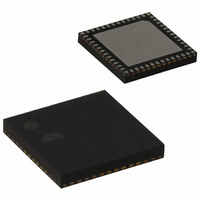EM357-RTR Ember, EM357-RTR Datasheet - Page 108

EM357-RTR
Manufacturer Part Number
EM357-RTR
Description
IC RF TXRX ZIGBEE 192KB 48QFN
Manufacturer
Ember
Specifications of EM357-RTR
Frequency
2.4GHz
Data Rate - Maximum
250kbps
Modulation Or Protocol
802.15.4 Zigbee
Applications
General Purpose
Power - Output
5dBm
Sensitivity
-100dBm
Voltage - Supply
2.1 V ~ 3.6 V
Current - Receiving
26mA
Current - Transmitting
31mA
Data Interface
PCB, Surface Mount
Memory Size
192kB Flash, 12kB RAM
Antenna Connector
PCB, Surface Mount
Operating Temperature
-40°C ~ 85°C
Package / Case
48-QFN
Lead Free Status / RoHS Status
Lead free / RoHS Compliant
Other names
636-1011-2
Available stocks
Company
Part Number
Manufacturer
Quantity
Price
Company:
Part Number:
EM357-RTR
Manufacturer:
SILICON
Quantity:
3 000
Part Number:
EM357-RTR
Manufacturer:
SILICON
Quantity:
20 000
- Current page: 108 of 245
- Download datasheet (12Mb)
EM351 / EM357
A DMA buffer’s end address, SCx_TXENDA/B (or SCx_RXENDA/B), can be written while the buffer is loaded or
active. This is useful for receiving messages that contain an initial byte count, since it allows software to set
the buffer end address at the last byte of the message.
As the DMA channel transfers data between the transmit or receive FIFO and a memory buffer, the DMA count
register contains the byte offset from the start of the buffer to the address of the next byte that will be
written or read. A transmit DMA channel has a single DMA count register (SCx_TXCNT) that applies to
whichever transmit buffer is active, but a receive DMA channel has two DMA count registers (SCx_RXCNTA/B),
one for each receive buffer. The DMA count register contents are preserved until the corresponding buffer, or
either buffer in the case of the transmit DMA count, is loaded, or until the DMA is reset.
The receive DMA count register may be written while the corresponding buffer is loaded. If the buffer is not
loaded, writing the DMA count register also loads the buffer while preserving the count value written. This
feature can simplify handling UART receive errors.
The DMA channel stops using a buffer and unloads it when the following is true:
(DMA buffer start address + DMA buffer count) > DMA buffer end address
Typically a transmit buffer is unloaded after all its data has been sent, and a receive buffer is unloaded after
it is filled with data, but writing to the buffer end address or buffer count registers can also cause a buffer to
unload early.
Serial controller DMA channels include additional features specific to the SPI and UART operation and are
described in those sections.
8-33
120-035X-000G
Final
Related parts for EM357-RTR
Image
Part Number
Description
Manufacturer
Datasheet
Request
R

Part Number:
Description:
MODULE EM357 PA/LNA W/ANT TG
Manufacturer:
Ember
Datasheet:

Part Number:
Description:
MODULE EM357 NO PA/LNA W/ANT TG
Manufacturer:
Ember
Datasheet:

Part Number:
Description:
MODULE EM357 NO PA/LNA W/RF CONN
Manufacturer:
Ember
Datasheet:

Part Number:
Description:
MODULE EM357 PA/LNA W/RF CONN
Manufacturer:
Ember
Datasheet:

Part Number:
Description:
IC RF TXRX ZIGBEE 192KB 48QFN
Manufacturer:
Ember
Datasheet:

Part Number:
Description:
KIT DEV EMBER ZIGBEE W/PCWH
Manufacturer:
Custom Computer Services Inc (CCS)

Part Number:
Description:
PROGRAMMER USB FLASH EM250/260
Manufacturer:
Ember
Datasheet:

Part Number:
Description:
IC ZIGBEE SYSTEM-ON-CHIP 40-QFN
Manufacturer:
Ember
Datasheet:

Part Number:
Description:
IC ZIGBEE SYSTEM-ON-CHIP 48-QFN
Manufacturer:
Ember
Datasheet:

Part Number:
Description:
IC RF TXRX ZIGBEE 128KB 48QFN
Manufacturer:
Ember
Datasheet:

Part Number:
Description:
INSIGHT ADAPTER FOR EM2XX
Manufacturer:
Ember
Datasheet:

Part Number:
Description:
PROGRAMMER USB FLASH EM250/260
Manufacturer:
Ember
Datasheet:

Part Number:
Description:
IC ZIGBEE SYSTEM-ON-CHIP 40-QFN
Manufacturer:
Ember
Datasheet:

Part Number:
Description:
IC ZIGBEE SYSTEM-ON-CHIP 48-QFN
Manufacturer:
Ember
Datasheet:

Part Number:
Description:
IC RF TXRX ZIGBEE 128KB 48QFN
Manufacturer:
Ember
Datasheet:











